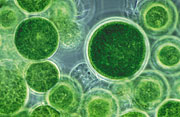- Number 352 |
- December 12, 2011
Unlocking algal secrets may help clean up radioactive isotopes

Algae could form the basis of
new technologies.
Using the Advanced Photon Source at DOE's Argonne National Laboratory, a group of Northwestern University and Argonne scientists have figured out the secrets of algae that can preferentially take up strontium over calcium-a task so difficult that it's not easily done even in a laboratory. The algae could form the basis of new technologies to clean up contaminated land or water.
Strontium-90 is one of the deadly isotopes produced by nuclear weapons and reactors. If it's ingested in contaminated food or water, the human skeleton may take it up instead of calcium-where it can sit for decades, poised to trigger bone cancer or leukemia.
"The difficulty with cleaning up strontium-90 from the environment is that it's so similar to calcium and barium that scientists even have trouble doing it in the laboratory, with sophisticated equipment," explained lead author Minna Krejci, who has a joint appointment at Northwestern and Argonne.
Krejci and the team used a type of imaging called X-ray fluorescence microscopy to track the movement of metals through the components of a cell. By comparing the data with physical photos of the cells taken with an electron microscope, they found that high concentrations of sulfur in the vacuoles-the cell's storage compartments- meant more strontium pulled up into crystals. This type of mechanism is called a sulfate trap.[Jared Sagoff, 630.252.5549,
jsagoff@anl.gov]
